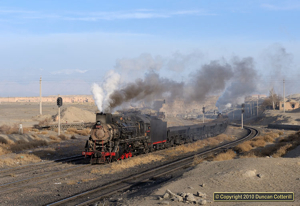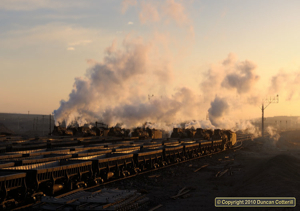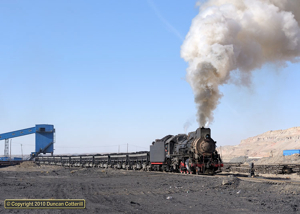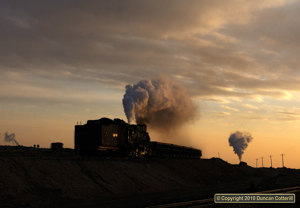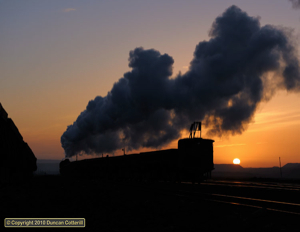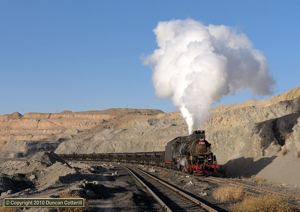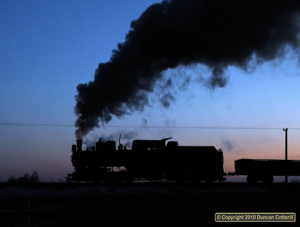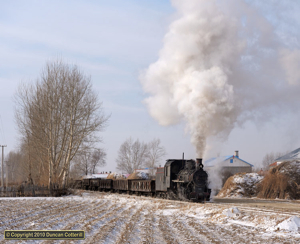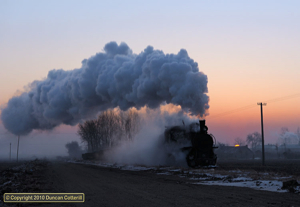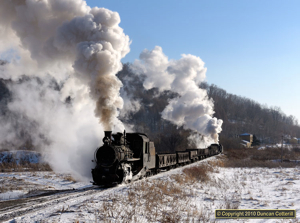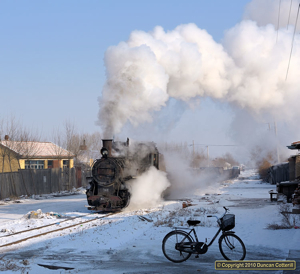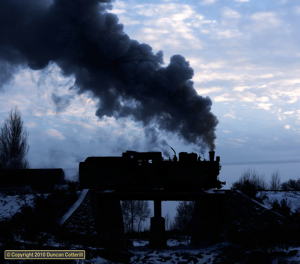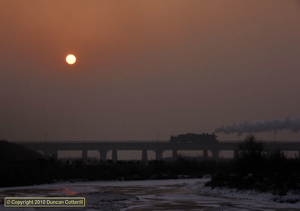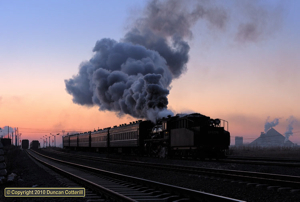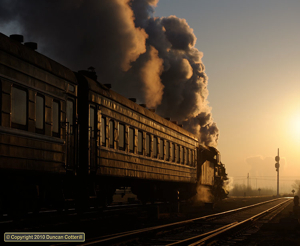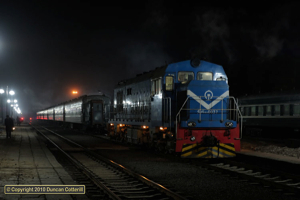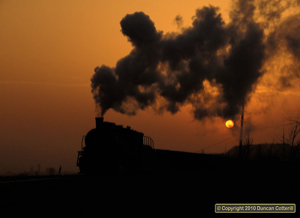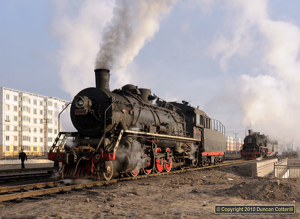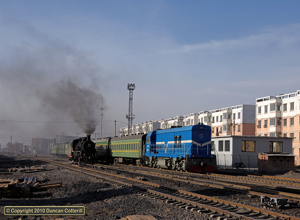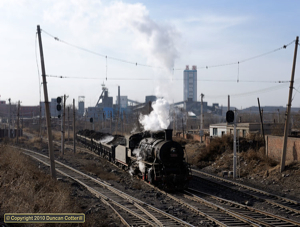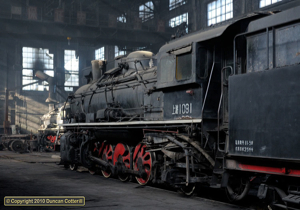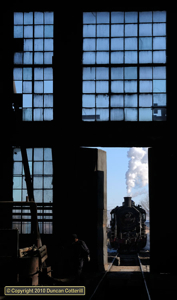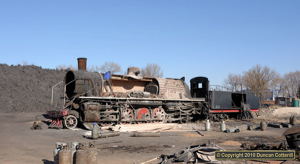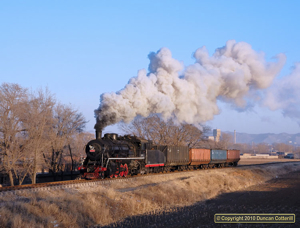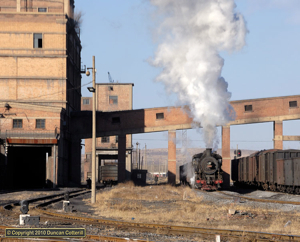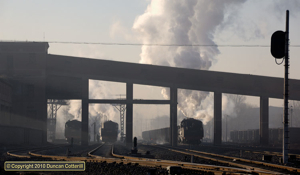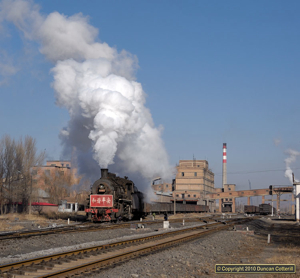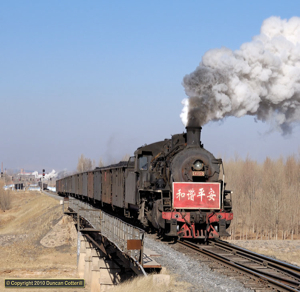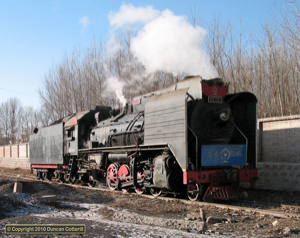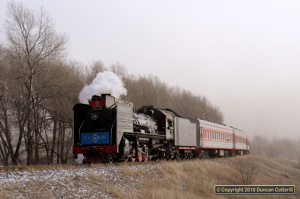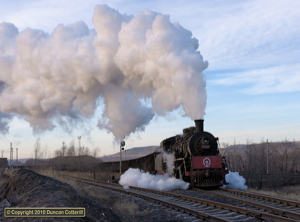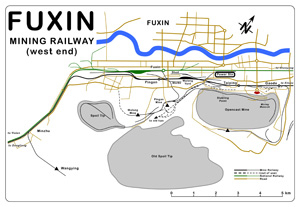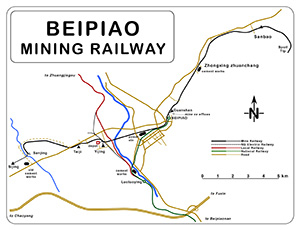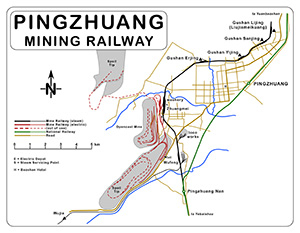Industrial Survivors
22 November - 11 December 2010
Report by Duncan Cotterill
Introduction
The steam era is rapidly drawing to a close in China and most of the remaining operations have plans to modernise over the next couple of years. We visited nine of the remaining railways in November and December 2010. Read on to see what we found. A full list of loco numbers can be found here.
Sandaoling Mining Railway
(22 to 24 November)There have been two major developments since my last visit to Sandaoling in November 2009. On the negative side, the railway has acquired four diesel locomotives to work trains between Nanzhan and the state railway interchange at Liushuquan, virtually eliminating steam from one of the most photogenic parts of the operation. On the positive side, coal is no longer transported all the way from the opencast coal face to the washery by train. Instead, it goes to Xikengkou, situated on a ledge just inside the rim of the pit, by conveyor and from there to the washery by train. This may not seem like a positive development at first glance but in order to use the new loading point, trains are now hauled out of the pit by chimney-first locos instead of being propelled, a huge improvement from a photographer’s perspective.
The surface section of the operation, based at Nanzhan, now has four powerful DF8B diesels available (DF8B 0247, 0248, 0249 and 0250) but was only using one of them to shuttle trains between Nanzhan and Liushuquan during our visit. The other three were stabled in Nanzhan yard with nothing to do. Trains from Nanzhan to the deep mines at Beiquan and the washery shunt were still steam worked. Three JS were seen in use (JS 8053, 8314 and one other, probably JS 8366).
Spoil train operations, based at Xibolizhan at the west end of the opencast mine, were still 100% steam worked. Traffic volumes appeared to have only declined a little despite the use of lorries to transport spoil to new dumps within the disused east end of the pit. The morning shift change at 09:00 still involved around seven or eight spoil trains, plus the spreader, the passenger train and one or two construction trains. JS 6436 was the regular loco on the spreader and SY 1593 and 1720 on the construction trains. JS 6224, 6261, 8076, 8078, 8167, 8188, 8190, 8194, 8195 and 8225 were in use on the spoil trains. A construction or coal train engine was borrowed to work the passenger. All the locos were in poor external condition, a marked change from previous years.
The main attractions, as far as I was concerned, were the coal trains out of the opencast pit. Three trains were in use and, when things were running smoothly, loaded trains left the pit at 25 – 30 minute intervals, around twice as frequently as a year ago. Two of the cleanest engines, JS 8173 and 8368 were on the coal trains along with JS 8193. JS 8190 also put in a brief appearance.
Huanan Forestry Railway
(26 November to 01 December)The miracle of Huanan continues. How such a run-down, unreliable, anachronistic and truly wonderful operation can survive into the second decade of the 21st Century is beyond me but somehow it just keeps going. Long may it continue.
We arrived at Huanan to find the railway at a standstill with all the engines out of action. 041 and 168 were cold in the shed while 044 and 011 were in steam but under repair. 004 was said to be at Lixin and in need of attention. Eventually 011 was deemed fit for service and left for Lixin just after sunset with a train of empties and a repair crew to fix 004.
That was how it continued during the six days we were there, locos failed, locos were repaired and the railway somehow managed to keep going. Much of the time there were only two locos available for traffic and sometimes only one. Intervals between trains could be eight hours or more, a problem when sunrise and sunset are less than nine hours apart. We got to know the phrase “huoche huaile” very well (the train is broken). Fortunately, the worst days for availability were also the worst for weather, so we didn’t lose too many opportunities in good light. However, there wasn’t a single day when the planned four-hourly pattern was maintained from dawn to dusk.
The same three locos, 004, 011 and 044 continued in use throughout our visit but 041 and 168 remained at the depot. The spark arrestors mentioned in previous reports are only used at times of high fire risk and had been removed by the time we arrived. The passenger service, operated by railcars a few years ago appears to have ceased permanently.
Jixi Mining Railway
(26 November & 02 December)Steam operations at Jixi have taken a major turn for the worse since our last visit in March 2010. Every line except Chengzihe now has diesels and Chengzihe has been ruined by poles for the impending electrification. In the light of these developments we shortened our visit by a day and just spent two mornings at Jixi en-route to and from Huanan.
On the Chengzihe system there are still a few sections clear of poles, principally the main river bridge north of Qiaonan, a short section of the main line near Nanchang, Beichang washery and the connecting lines to Nanchang and Dongchang and the Zhengyang end of the line to Xinghua. The poles are all very closely spaced, ruining any possibility of photography on the sections that have already been completed. Although most of the poles have been erected, we saw no evidence of wiring anywhere, so it will be some time before electric operation begins. This is only of academic interest as there are now very few spots where it’s worth taking pictures.
Everything was still steam worked with the regulars joined by SY 0951 ex-Lishu. Nine locos were present at Dongchang for shift change on 26 Nov; SY 0863, 0951, 1058, 1340, 1351, 1369, 1437, 1544 and 1545.
The Didao system has recently received a number of DF4 diesels. We paid a brief visit at lunchtime on 26 November. DF4 9305 was in the yard at Hebei washery and DF4 1964 arrived shortly afterwards with empty tippers from the power station. Both locos still carried Harbin Bureau, Mudanjiang Depot allocation codes with no lettering anywhere to suggest that they belonged to the mining railway, so it is almost certain that these are CR locos on hire.
SY 1446 was seen heading in the direction of Jixi CR station when we arrived and returned to Hebei light engine shortly afterwards. The other four steam locos based here, SY 0407, 0950, 1205 and 1213 were stored in a fenced compound within the washery yard and easily visible from the entrance road.
Tiefa (Diaobingshan) Mining Railway
(03 to 04 December)Tiefa currently has only two working steam locos, SY 1770 and SY 1771, and both were in use on passenger trains. SY 1772 has gone into store in the “Exhibition Hall” at Daqing Loco Depot along with the line’s other steam locos. Most work on the system is done by a fleet of DF5B and DF4B diesels. We saw seven DF5B (0037, 0038, 0039, 0052, 0053, 0059 and 0060) and two DF4B (7755 and 7772) in use. Previous reports had only listed three DF5B and five DF4B. All six of the DFH3 diesels that previously worked here are dumped in the depot area.
The “Exhibition Hall” contained JS 5029, KD6 487, YJ 269, SY 0393, 0435, 0665, 0860, 0979, 1147, 1183, 1255, 1412, 1683, 1749, 1751, 1767, 1769 and 1772. Another two SYs were more difficult to identify, one was coupled to a tender numbered 0023 but we could find no identifying marks on the loco itself. SY 0023 was assumed scrapped several years ago. The second loco, in ex-works condition, had no painted numbers but the air-receiver plate was stamped 1114 and the builder plates, dated 1980/8, are consistent with it being SY 1114, a Beitai Steelworks loco reported to be at Tiefa for overhaul in 2009. The one loco we expected to see but didn’t was SY 0063, thought to be the centrepiece of the display in the museum building. A notice outside the “Exhibition Hall” listed the JS, YJ, KD6 and SY 1767, 1770 and 1771 as being in working order.
Friday 03 December was a poor day for steam with SY 1770 working train 202 (06:16 Wangqian - Diaobingshan) and train 301 (07:16 Diaobingshan - Daqing) before retiring to the depot. It reappeared in the early evening at Diaobingshan, arriving light engine from Daqing then disappearing again without working a train. The other loco, SY 1771 remained at Daqing depot until the evening then travelled to Diaobingshan light engine and remained there until the following morning.
Saturday 04 December was better with both locos working early morning trains. SY 1770 worked 201 (06:28 Diaobingshan - Wangqian) and 204 (08:02 Wangqian - Diaobingshan). SY 1771 worked 202 (06:16 Wangqian - Diaobingshan), 301 (07:16 Diaobingshan - Daqing) and 308 (08:35 Daqing - Diaobingshan). We left for Fuxin shortly afterwards so didn't see what the steam locos did for the rest of the day.
Note that 308 runs approximately 30 minutes earlier than previously, arriving Diaobingshan at 09:04. Trains 307 to Daqing and 310 from Daqing no longer run. All other trains run within a couple of minutes of the times previously published.
Fuxin Mining Railway
(04 to 05 December)Due to the decline in steam operations at other locations, Fuxin has become one of the steamiest places left in China with at least 12 locos in steam on 05 December. Unlike some railways, operations are spread out and it can be difficult to track down working engines.
Much of our time was spent exploring the area around Wulong Mine, a modern colliery around 2km south-west of Wulong Yard. The line to the mine leaves the main line just east of Pingan station in a south-easterly direction and then swings round to the south-west and climbs to a point just short of the mine. There were several connections from this line into the complex of lines serving the opencast mine but most are now disused. A line branches off just before the colliery and climbs to an active spoil tip west of the mine. The mine produces coal for the power station east of Wulong Yard, sent out in side tippers, and for further afield, shipped in CR wagons. The spoil tip handles spoil from the local mine and from other mines on the system. As locations go, it’s not particularly photogenic (Where in Fuxin is?) and the former electrification masts get in the way but it is fairly busy and, as far as we could tell, 100% steam worked. I’ve drawn a map showing the west end of the Fuxin system, including the area around Wulong mine. It’s interesting to compare this with the map in CRJ 124, showing the situation ten years ago.
The infrastructure associated with the opencast pit is slowly disappearing with the washery now demolished and many of the lines in and around the pit either lifted or disused. Most of the overhead wiring has been dismantled but quite a few poles remain to make photography more difficult.
Two diesels were seen, DF5D 0067 and 0068, one working the Xinqui - Wangying passengers and the other on coal traffic, working between the CR yard and Wulong yard and also the line west towards Wangying.
The morning line up at Wulong on 05 Dec comprised SY 0770, 0988, 1210, 1319, 1320, 1378, 1460, 1818(1414) and DF5D 0068.
Additionally SY 0941, 1396 and 1397 were all in steam at the servicing point at lunchtime (along with SY 1818). SY 1395 and another, unidentified, SY were seen at midday, running light-engine towards the opencast mine. We didn't get to Taiping stabling point to check if there were any engines there.
The loco at the mining museum, masquerading as another SY 1395, is a fake, probably SY 0939 judging from the painted over number on the tender but it carries 1974/11 plates and SY 0939 should have 1975/01 plates. The stamped plate on the air receiver looked like a replacement and didn’t yield any useful information.
The other duplicate number that has been reported here is SY 0770. The one seen at Wulong appears to be the real thing with 1974/01 plates. We didn't see the second SY 0770, reported to be dumped at the carriage sidings adjacent to the servicing point, but the other locos reported in April by David Thomas were still there (JF 508, SY 0036, 0076, 0127, 0391, 0540, 0576), although 0127 and 0540 weren't 100% positively identified. We didn't explore the other dumps around Fuxin.
Beipiao Mining Railway
(06 to 07 December)This was our first visit to Beipiao and probably our last. Previous reports indicated that the line was fairly uninspiring, that there wasn’t much activity and that trains were difficult to predict, so we didn’t expect much.
We found three locos at the depot in working order but cold (SY 1091, 1196 and 1550) with JF 886 stored in the wagon works. There were only two steam locos in use, SY 1004 and 1451 plus a diesel, DF5 1113. The DF5 was built in 1991 and is almost certainly second hand ex-CR. It carries the mining company logo and lettering and there are pictures of it being handed over on the noticeboard outside the offices at Guanshan. In a compound near the depot, two locos, SY 0183 and 0387 were being cut up for scrap. We were told that two or three more diesels were on order and expected to arrive sometime next year, enough to finish steam working at Beipiao. As SY 1451 has a 2010 overhaul date and SY 1091 and 1550 were overhauled in 2009, there shouldn’t be too much pressure to acquire new diesels quickly.
Most of 06 December was spent at the western end of the system around Yijing, Taiji and Sanjing. SY 1004 worked a train of empties to Taiji, passing Yijing at 08:45 and then returned with loads just after 10:00, leaving its train at Yijing and going on shed for servicing. It then disappeared towards Guanshan light engine but returned just before 12:00, collected the loads and took them to Guanshan.
We were told that there might be a train of empties to Taiji around 13:30 and there would be a train to Sanjing around 15:30. The Taiji train didn’t show up so we found a spot in open country, west of Taiji, and waited for the Sanjing train. The locals confirmed that there was usually a train around 16:00. Sure enough, SY 1451 appeared with a short train of empties at 15:38, just a few minutes before the sun dropped behind the hills.
07 December began with a visit to the washery at Guanshan where SY 1004 was shunting. In the two hours we were there the loco appeared several times at the photogenic south end of the washery but it was always propelling and never positioned itself in a good spot for photography. DF5 1113 took a train of empties out towards Taiji around 08:30 and SY 1451 disappeared towards Sanbao with some side tippers loaded with spoil around 09:30.
We photographed SY 1451 returning from Sanbao at a village called Sanjiazi (sounds strangely familiar) at 11:45 then went to Yijing where the information on afternoon workings was the same as the previous day. Only the Sanjing train ran but it was a light engine going out, returning with three loaded wagons.
Beipiao is a difficult system to photograph satisfactorily but there are some reasonable locations towards Sanbao and Sanjing. Trains weren’t as unpredictable as we were led to believe and the Control Office staff at Yijing were helpful in indicating what was likely to run. My feeble brain can’t handle maps with north down and south up so I drew my own map. There’s not much that isn’t on Bernd’s map but note that it’s possible to follow the line all the way from the crossing near Taiji to Sanjing on a reasonable dirt road.
Pingzhuang Mining Railway
(08 to 11 December)The Pingzhuang system has plenty of photographic potential with 100% steam operation on the deep mine system and attractive industrial backdrops at the washery and some of the deep mines. Realising that potential isn’t so easy. Trains rarely seemed to run in the right direction at the right time for the light and a seemingly imminent departure could turn into a wait of several hours followed by three puffs, shut off and coast out of the yard. Some crews were keen and we managed to photograph a couple of very vigorous shunts around the washery, others seemed masters of the technique of getting a very heavy train on the move without using any steam at all.
Trains were difficult to predict and there were a lot of light engine movements. Instead of taking a loaded train to Pingzhuang Nan and returning with empties, normal practice seemed to be to send a light engine to Pingzhuang Nan to collect the empties then send another engine with the loads. The trains would often cross at Wufeng, a task made more difficult when the empty train was longer than the loops at the station. Long trains of empties were often split at Wufeng but it wasn’t clear whether the wagons left there were destined for Wujia mine or would be taken to the washery later. We also saw a short working from the Gushan mines that only went as far as Gushan Erjing, where the coal was unloaded in the sidings behind the loading point.
As with many mining operations in the north-east, shift change is around 08:00 to 09:00 and several locos gather at the servicing point at Zhuangmei washery to change crews and take coal and water before resuming work. Four SYs (SY 1017, 1079, 1425 and 1441) handled all the work on the deep mine system. Two more, SY 1052 and 1487 were only seen at the shift change and each on only one occasion. They were probably visitors from the opencast system, which we didn’t manage to check out. Gauging from what we could see and hear from the other side of the washery, there was still a fair amount of steam and electric activity on the opencast system. The works compound appeared to contain a number of dumped locos, including several JS, as reported by previous visitors but, again, we didn’t manage to check it out.
Once again, I’ve drawn a map of the area, showing the whole mine railway system. Lines shown out of use on the opencast side are based on information in David Thomas’s April 2010 report.
Yuanbaoshan Mining Railway
(09 to 11 December)Two JS were in steam at Yuanbaoshan on the three days we visited, JS 6245 and 8250. Another loco, JS 8249, was seen being shunted from one road to another at the shed. Although it wasn’t in steam, JS 8249 was clearly an operational loco and, like the other two, commendably clean. The two working engines appeared to share the available duties and, on one occasion, both were in use at the same time. Steam duties seemed to consist of the passengers to/from Fengshuigou plus the occasional trip or shunt, as required. In other words, there wasn’t a lot for the locos to do and they spent most of their time sitting around. None of the four passenger workings we saw conveyed any freight wagons.
Two diesels were seen, DF12 0106 and 0107. They handled most of the coal traffic including significant volumes from a new mine near Fengshuigou. Further south, a new power station appears to be under construction east of the line between Yuanbaoshan CR and Majiawan and a rail connection to Majiawan is under construction. The whole Yuanbaoshan area appears to be set for significant industrial expansion with a number of new roads open or under construction and several new industrial plants being built.
Hongmiao Mining Railway
(10 to 11 December)SY 1565 was in steam with SY 1418 undergoing an overhaul in the workshop.
This operation has had a few visitors in the past but descriptions have been fairly sketchy, so here goes... The line is around 2km long and runs generally northwards from the mine before swinging slightly to the north-west just before Malin, the interchange with CR’s Chifeng - Yebaishou main line. Malin is the first station north of Yuanbaoshan.
The yard, loader and workshop at Hongmiao mine are outside the secure area so access is fairly easy. The mine yard is quite open but the line to Malin is tightly treed in and very difficult for photography. There are a few slightly clearer spots just outside Malin but nothing particularly photogenic. The line climbs gently in both directions to a summit a short distance from Malin so trains departing from either end have to work. Locos face south so loaded trains are tender first and the empties chimney first.
The mine appears to be quite productive but there isn’t much steam activity, perhaps a train of loads out and a train of empties in every six hours or so. The loader is equipped with winches so the loco just positions the empties then retires to the yard to wait for them to be filled. We called in at the mine on several occasions but only saw any activity on our final visit. SY 1565 made a very spirited departure from the mine with around 30 loaded wagons and kept working hard until just before Malin. The return departure with empties, 45 minutes later, was equally impressive.
China Railway
Our first encounter with the main line railway was when we travelled from Wulumuqi to Hami overnight on 21-22 November. DF11 0190 was the power for train K9872 and numerous diesel hauled trains were passed in the night. It was also possible to hear diesel hauled freights on the main line west of Hami when we were at Sandaoling.
In the Jixi area, NHX5 (Qishuyan/GE) diesels appear to work most freights on the line west to Linkou. They might not be the most visually attractive locos but they sound fantastic with loud, thumping engines and the most gorgeous horns that carry right across the city. Further north, standard DF4Bs seemed to be the power of choice for freights passing through Huanan. Going west from Mudanjiang towards Harbin, there were still a lot of NHX5s but also a good number of DF8s as well.
Freight in the Fuxin area was a mixture of DF4B and DF4C with red and cream DF4D or orange DF4B on the few passengers we saw. DF4C were also present in the Beipiao area, working both the freights we saw. North of Yebaishou, freights were powered by a mixture of DF4B, DF4C and new HXN3 (Dalian/EMD) diesels, all based at Tongliao. The HXN3s lack the satisfying roar and the tuneful horns of the HXN5s and look even uglier in my view. The only passenger seen was hauled by a DF4D.
Our train back to Beijing from Chifeng, the good old 2560, had DF4D 0032, also from Tongliao depot on the front into the new Beijing Bei station, and presumably all the way from Chifeng.
A New Line
Construction work for a new railway could be seen all the way along the new expressway from Chaoyang to just outside Pingzhuang and also in the Yuanbaoshan area. The new line crashes headlong through the mountainous terrain and is in tunnels or on high viaducts for much of its length. The line is almost certainly a new coal railway linking Chifeng with Jinzhou, presumably fed with coal from the new mines north of Daban. The structures look to be designed for single track but it isn’t clear whether it will be electrified or diesel worked. The other question is whether it will connect to the mining lines in the Yuanbaoshan or Pingzhuang areas. We certainly saw no evidence that it would.
Travel & Accomodation
We used air, rail and road transport to get around, flying from Beijing to Wulumuqi then taking the train to Hami and using a minibus to get around in the Sandaoling Area. Arrangements at Sandaoling were made through Gu Li and CITS at Hami. Everyone at Sandaoling was very friendly but it was clear that the mining company took security seriously and we had to report our position at all times when on company property.
The journey back to Beijing was the reverse of the outward trip, by train to Wulumuqi then air to Beijing. After being fogged in at Wulumuqi for almost two days last year, it was a little concerning to find the city foggy when we arrived but, thankfully, not enough to affect operations at the airport. Prospective visitors to Sandaoling should be aware that on several occasions during our three weeks in China, Wulumuqi airport was closed by fog.
From Beijing we flew to Mudanjiang then travelled to Jixi and Huanan by minibus, returning to Mudanjiang to catch overnight train 2018 to Tieling where we were met by another minibus. This took us around the Tiefa, Fuxin, Beipiao, Pingzhuang and Yuanbaoshan areas before finally dropping us at Chifeng for the overnight train back to Beijing. New expressways made travel in this area much easier than before. Tiefa to Fuxin took around 2hr30, Fuxin to Beipiao, 1hr30 and Beipiao to Pingzhuang around 2hr, much quicker than we had anticipated.
Although the internal travel arrangements worked smoothly, the same couldn’t be said about the journeys from the UK to China and back. We made the mistake of flying with KLM and suffered serious delays in both directions. On the way out, our 747 (appropriately call sign “FU”) had engine problems at Amsterdam and after a lot of faffing about, the flight was cancelled. We were eventually rebooked on flights the following day, via Helsinki and Hangzhou respectively, and sent to the Ibis for the night. Everything went smoothly the following day but we arrived in Beijing a day late as a result. Fortunately, Xiaolan was able rebook our flights to Wulumuqi and rail tickets to Hami but the delay forced us to abandon our plan to visit Yamansu.
On the way back, guess what? Our 747 (this time call sign “FD”) had engine problems at Beijing and after a lot of faffing about, the flight eventually took off over 3 hours late. Unlike last year when there was a seven hour delay, again on KLM, we did get to Amsterdam in time to connect with evening flights back to the UK.
I’ve been on six long haul KLM flights. Five of them have been delayed significantly and three of those delays have been caused by engine problems. The total delay has been an incredible 78 hours or an average of over 12 hours per flight. Never again!
Comments & Conclusions
Despite the travel problems it was a relatively successful trip with almost 60 locos seen in steam and several pictures I’m very pleased with. At the beginning of the trip I thought that it might be the last time I visited China for steam but now I’m more hopeful that a return trip in late 2011 will still be worthwhile.
Sandaoling was excellent. We went with the aim of photographing the coal trains and succeeded in getting a good selection of well lit shots. Mission accomplished! Visitors with similar ideas should note that it takes quite a time for the light to get into the east end of the pit and the coal doesn’t start flowing for quite a time after the 09:00 shift change. No prizes for guessing where to go for the first hour or two!
Jixi is hardly worth visiting anymore. The electrification works at Chengzihe have ruined most of the good locations there and the arrival of diesels on the other systems has reduced steam working to a very low level. The fact that most of the diesels appear to be on hire and the steam locos have been carefully stored rather than dumped does hold a little hope for the future but I would be very surprised if steam was ever revived here. JIxi was probably the best industrial location in China in recent years and it’s sad to see it go.
Huanan was hard work with long gaps between trains at times and always a great deal of doubt about when the next train would turn up. On the one day that we had perfect weather, we took a gamble and went up the hill, with good results. The rest of the time was spent on the Huanan - Xiahua section where it was easier to get information and react to delays, mixed weather and out of course running. Despite the delays and some poor weather it was still an enjoyable visit with a number of memorable pictures. As usual, there must be considerable doubt whether Huanan can keep going for another year, particularly as loco reliability seems to have reached an all time low.
Tiefa wasn’t part of our original plan but the timing of the trains from Mudanjiang made it a better option than Fuxin for our first day in Liaoning. It was disappointing to find a lower level of steam activity than we expected but with around 12 diesels and only two SYs available, this was always a risk. We might have done better on the second day but the weather was too hazy for quality photography and we decided to press on to Fuxin.
Fuxin was better than expected with only a small reduction in steam use since my only previous visit in 2006. There has to be a lot of steam activity to keep 12 locos busy but it’s not immediately obvious where the action is. Having explored the area around Wulong mine, things are a little clearer but I still don’t feel that I understand the traffic patterns fully. Perhaps another visit is called for.
Beipiao was never expected to be very good, and that was before we knew they had bought a diesel. The reality was somewhat better than expected with the trains more predictable and information more readily available than we’d expected. It’s still a difficult line to photograph with the busiest section unphotogenic and downhill for chimney first trains.
Pingzhuang was just as frustrating as it used to be but we did eventually get a few worthwhile pictures. As with Fuxin, there was probably more going on at Pingzhuang than was immediately apparent.
Yuanbaoshan was only worth visiting as it was a short distance from Pingzhuang. The locos were the smartest we saw on the trip but the level of activity was too low to justify travelling far.
Hongmiao was interesting to visit but not particularly busy and certainly not photogenic.
